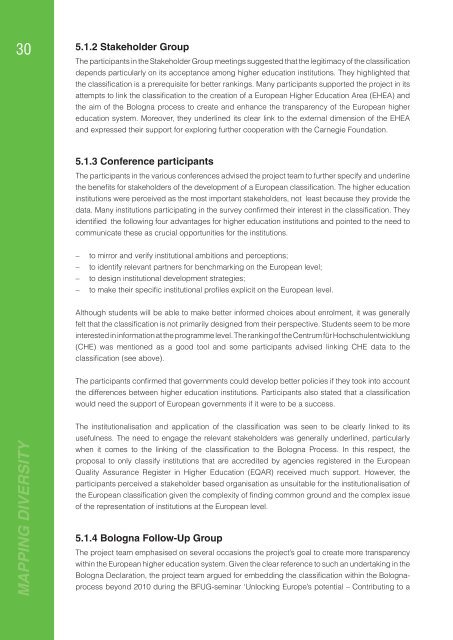Mapping Diversity: Developing a European Classification of ... - U-Map
Mapping Diversity: Developing a European Classification of ... - U-Map
Mapping Diversity: Developing a European Classification of ... - U-Map
Create successful ePaper yourself
Turn your PDF publications into a flip-book with our unique Google optimized e-Paper software.
30<br />
5.1.2 Stakeholder Group<br />
The participants in the Stakeholder Group meetings suggested that the legitimacy <strong>of</strong> the classifi cation<br />
depends particularly on its acceptance among higher education institutions. They highlighted that<br />
the classifi cation is a prerequisite for better rankings. Many participants supported the project in its<br />
attempts to link the classifi cation to the creation <strong>of</strong> a <strong>European</strong> Higher Education Area (EHEA) and<br />
the aim <strong>of</strong> the Bologna process to create and enhance the transparency <strong>of</strong> the <strong>European</strong> higher<br />
education system. Moreover, they underlined its clear link to the external dimension <strong>of</strong> the EHEA<br />
and expressed their support for exploring further cooperation with the Carnegie Foundation.<br />
5.1.3 Conference participants<br />
The participants in the various conferences advised the project team to further specify and underline<br />
the benefi ts for stakeholders <strong>of</strong> the development <strong>of</strong> a <strong>European</strong> classifi cation. The higher education<br />
institutions were perceived as the most important stakeholders, not least because they provide the<br />
data. Many institutions participating in the survey confi rmed their interest in the classifi cation. They<br />
identifi ed the following four advantages for higher education institutions and pointed to the need to<br />
communicate these as crucial opportunities for the institutions.<br />
−<br />
−<br />
−<br />
−<br />
to mirror and verify institutional ambitions and perceptions;<br />
to identify relevant partners for benchmarking on the <strong>European</strong> level;<br />
to design institutional development strategies;<br />
to make their specifi c institutional pr<strong>of</strong>i les explicit on the <strong>European</strong> level.<br />
Although students will be able to make better informed choices about enrolment, it was generally<br />
felt that the classifi cation is not primarily designed from their perspective. Students seem to be more<br />
interested in information at the programme level. The ranking <strong>of</strong> the Centrum für Hochschulentwicklung<br />
(CHE) was mentioned as a good tool and some participants advised linking CHE data to the<br />
classifi cation (see above).<br />
The participants confi rmed that governments could develop better policies if they took into account<br />
the differences between higher education institutions. Participants also stated that a classifi cation<br />
would need the support <strong>of</strong> <strong>European</strong> governments if it were to be a success.<br />
MAPPING DIVERSITY<br />
The institutionalisation and application <strong>of</strong> the classifi cation was seen to be clearly linked to its<br />
usefulness. The need to engage the relevant stakeholders was generally underlined, particularly<br />
when it comes to the linking <strong>of</strong> the classifi cation to the Bologna Process. In this respect, the<br />
proposal to only classify institutions that are accredited by agencies registered in the <strong>European</strong><br />
Quality Assurance Register in Higher Education (EQAR) received much support. However, the<br />
participants perceived a stakeholder based organisation as unsuitable for the institutionalisation <strong>of</strong><br />
the <strong>European</strong> classifi cation given the complexity <strong>of</strong> fi nding common ground and the complex issue<br />
<strong>of</strong> the representation <strong>of</strong> institutions at the <strong>European</strong> level.<br />
5.1.4 Bologna Follow-Up Group<br />
The project team emphasised on several occasions the project’s goal to create more transparency<br />
within the <strong>European</strong> higher education system. Given the clear reference to such an undertaking in the<br />
Bologna Declaration, the project team argued for embedding the classifi cation within the Bolognaprocess<br />
beyond 2010 during the BFUG-seminar ‘Unlocking Europe’s potential – Contributing to a

















